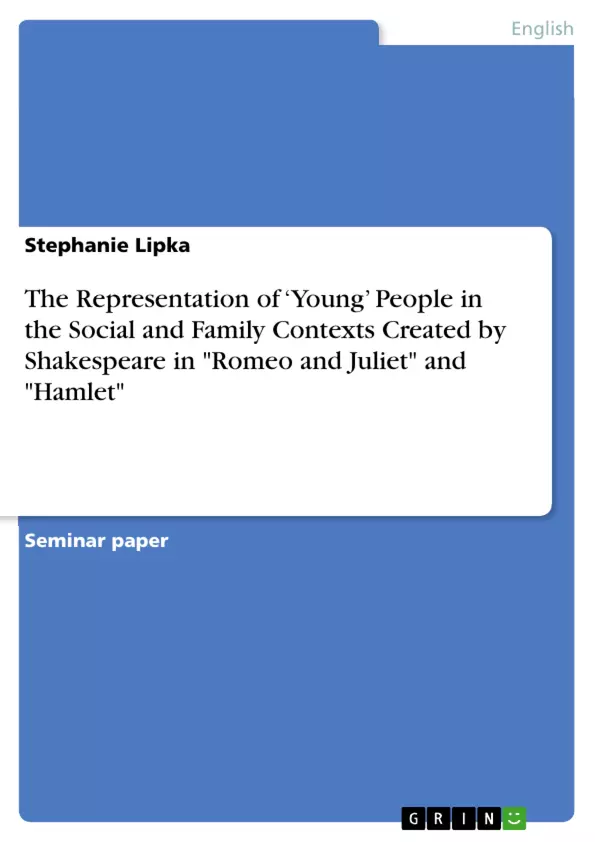Without any doubt, Shakespeare can be called one of the greatest observers of all
times. In his plays, the reader is confronted with characters from all sorts of social,
cultural and religious backgrounds. Among the most well-known characters, we find
kings, (their) queens and princes (like Hamlet), Jews (in "The Merchant of Venice"),
black people (Othello), and Roman soldiers, not to mention all those who did not
give a play its title. Looking at professions, Shakespeare employs characters from all
social levels - be they grave-diggers, jesters, killers or noblemen.
Within the plays, those characters seldom stand alone. They appear in groups, in the
context of their friends and families. A character is thus provided with a wife or
husband, a mother and father, maybe a step-parent, grand-parents, sisters, brothers,
girl- or boyfriends and mates. As a family does not consist of only one age group,
Shakespeare has to focus on several generations of characters, waving a complex net
of relations and interactions.
In this paper, I would like to look at the representation of ‘young’ people in two of
Shakespeare’s tragedies, "Romeo and Juliet" and "Hamlet". The term ‘young’ will be
reflected upon in my second chapter, as will be upon the term ‘tragedy’. As a future
teacher, the presentation of youth is an interesting topic for me, and looking at young
people interact (and interact with older characters) in Shakespeare will be something
worth doing: in focussing on youth, the cliché of tragedy often dealing with ‘old’
people will be broken. This paper is meant to show that Shakespeare did not write in
a single-dimensional way, but his plays offer a broad observation of any age group.
After giving a short synopsis of the two tragedies in chapter three, I will, in chapter
four, present the tragedies’ characters in their respective context and in relation to
each other and comment on their behaviour and attitudes.
In my conclusion, I will concentrate on the characters in their relation to the genre of
tragedy - reflecting on life, love, destiny, youth, and death.
Table of Contents
- Introduction
- A Definition of the Terms 'Young' and 'Tragedy'
- Youth
- Tragedy
- What happens in Romeo and Juliet and Hamlet?
- Synopsis of Romeo and Juliet
- Synopsis of Hamlet
- Young People in the Plays
- Young People in Romeo and Juliet
- Young People in Hamlet
- Conclusion "Sound and Fury"
Objectives and Key Themes
This paper explores the representation of 'young' people in Shakespeare's tragedies, Romeo and Juliet and Hamlet. The main objective is to analyze how Shakespeare portrays youth within the social and family contexts of these plays. The analysis aims to break the cliché that tragedy primarily deals with older individuals and demonstrate the multifaceted way Shakespeare portrays characters of all ages. Key themes of the paper include:- The definition and characteristics of 'youth' in Shakespeare's time.
- The role and significance of young characters in the two tragedies.
- The portrayal of family dynamics and social structures in relation to youth.
- The relationship between youth and the concept of tragedy.
- The impact of Shakespeare's depiction of youth on his audience.
Chapter Summaries
The first chapter introduces the topic of the paper and discusses Shakespeare's mastery of portraying diverse characters from various social and cultural backgrounds within his plays. It highlights the focus on family dynamics and the interaction between characters across different generations, establishing the context for the analysis of 'young' characters. The second chapter delves into the definition of 'young' and 'tragedy'. It explores different interpretations of youth, highlighting the physical, mental, and social aspects of adolescence. The chapter also discusses the historical context of Shakespeare's time and how the concept of youth might have been understood then. The definition of tragedy is then addressed, emphasizing its focus on negative aspects of life, decay, death, and loss. The third chapter provides a synopsis of Romeo and Juliet and Hamlet, outlining the main plot points and introducing key characters. These synopses serve as a foundation for the detailed analysis of the characters and their interactions in subsequent chapters.Keywords
This paper explores the representation of youth in Shakespeare's tragedies, focusing on Romeo and Juliet and Hamlet. The main keywords and themes are: youth, tragedy, Shakespeare, Romeo and Juliet, Hamlet, family dynamics, social context, character analysis, and the portrayal of human emotions and experiences within the framework of dramatic storytelling.- Quote paper
- Stephanie Lipka (Author), 2002, The Representation of ‘Young’ People in the Social and Family Contexts Created by Shakespeare in "Romeo and Juliet" and "Hamlet" , Munich, GRIN Verlag, https://www.grin.com/document/126034



